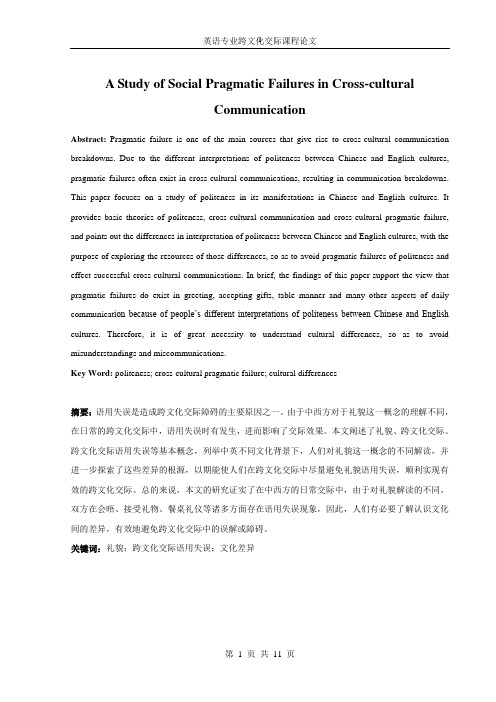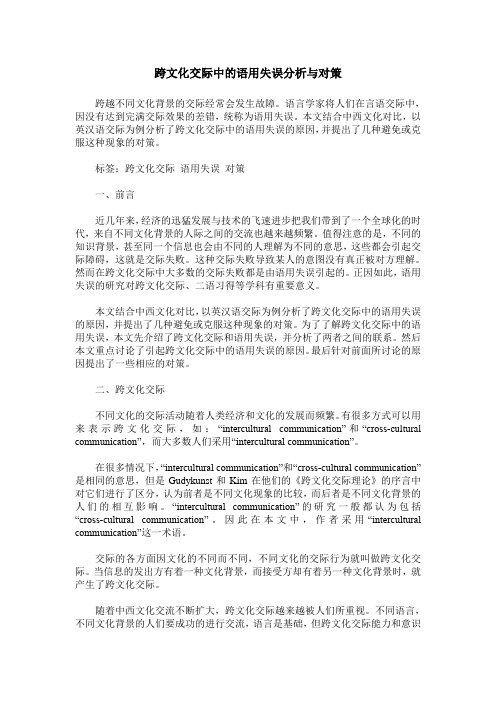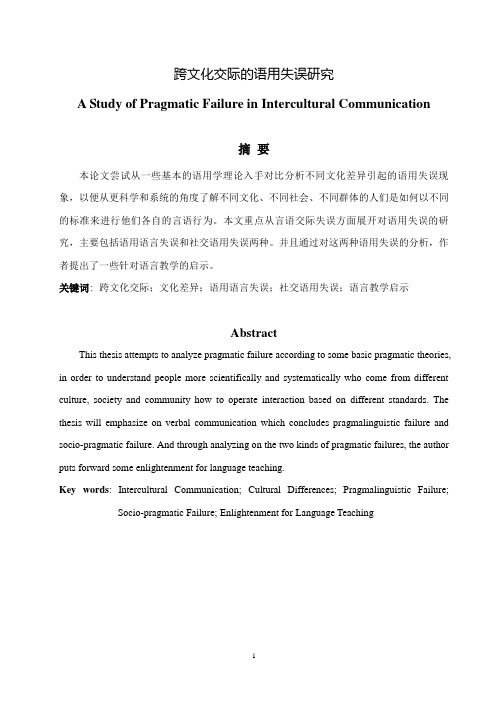跨文化交际中的语言失误英语专业毕业论文跨文化交际方向
开题报告 跨文化交际的语用失误

中国矿业大学徐海学院英语专业《英语学术论文写作》课程论文*名:____***_________班级:_____英语08-1______学号:_____********______成绩:__________________2011.10论文开题报告论文题目:浅析跨文化交际中的语用失误论文题目:Analysis of Pragmatic Failure in Cross-culture Communication一、本选题的国内外研究现状、水平和发展趋势1. 研究现状珍妮·托玛斯(Jenny Thomas)于1983年在其“跨文化语用失误”一文中首次提出了语用失误这一概念,这位跨文化语用失误及其原因的研究奠定了理论基础。
在国内,黄次栋于1984年在其“语用学与语用错误”一文中首次提出了“语用错误”这一概念。
他详细阐述了十种不同的语用错误并且指出,在语言学习中,除了要掌握必要的语言知识如语音、语法和词汇等外,更重要的是要掌握不同的语言形式在不同的非言语语境和背景下的运用。
他还建议有关言语行为中的语用内容应该增加到大纲中并且教授给学生。
自此,有关语用失误的研究日益增多,许多学者对学习者语用失误的原因进行了研究并提出了有效的减少语用失误的方法。
继黄次栋之后,何自然、严庄(1986)对语用失误进行了量的研究,他们以托玛斯的理论为基础,在其“中国学生在英语交际中的语用失误——汉英语用差异调查”一文中,对来自几所大学的79名语言教师在语言语用失误和社交语用失误方面的汉英差异进行了调查,结果表明,导致语用失误的主要原因是语言语用知识和社交语用知识的缺乏。
由此,他们提出,在课堂教学中应该教授跨文化语用知识。
他们的研究对于探索和分析中国学生的语用失误有极大的实际价值。
他们所采用的问卷也为今后语用失误的研究提供了一个范例。
此外,王得杏(1990)将语用失误的研究扩展到跨文化语用失误的研究,并且解释了语用失误的原因及减少语用失误的方法。
跨文化交际中的语言失误(英语专业毕业论文_跨文化交际方向)

A Study of Social Pragmatic Failures in Cross-culturalCommunicationAbstract: Pragmatic failure is one of the main sources that give rise to cross-cultural communication breakdowns. Due to the different interpretations of politeness between Chinese and English cultures, pragmatic failures often exist in cross-cultural communications, resulting in communication breakdowns. This paper focuses on a study of politeness in its manifestations in Chinese and English cultures. It provides basic theories of politeness, cross-cultural communication and cross-cultural pragmatic failure, and points out the differences in interpretation of politeness between Chinese and English cultures, with the purpose of exploring the resources of those differences, so as to avoid pragmatic failures of politeness and effect successful cross-cultural communications. In brief, the findings of this paper support the view that pragmatic failures do exist in greeting, accepting gifts, table manner and many other aspects of daily communicat ion because of people’s different interpretations of politeness between Chinese and English cultures. Therefore, it is of great necessity to understand cultural differences, so as to avoid misunderstandings and miscommunications.Key Word: politeness; cross-cultural pragmatic failure; cultural differences摘要:语用失误是造成跨文化交际障碍的主要原因之一。
英语翻译毕业论文选题

英语翻译毕业论文选题英语翻译毕业论文选题随着全球化的不断发展,英语翻译作为一项重要的语言技能变得越来越受重视。
作为英语翻译专业的学生,选择一个合适的毕业论文选题是非常重要的。
毕业论文选题的选择应该充分考虑到个人兴趣和专业发展的需求。
在这篇文章中,我将探讨一些适合英语翻译毕业论文选题的主题,以帮助学生更好地选择合适的研究方向。
一、跨文化交际中的语言障碍跨文化交际中的语言障碍是英语翻译专业学生研究的一个重要领域。
在全球化的背景下,不同语言和文化之间的交流变得越来越频繁。
然而,由于语言和文化的差异,跨文化交际中常常出现误解和沟通障碍。
学生可以选择研究不同语言和文化之间的交际问题,探讨语言障碍产生的原因以及如何克服这些障碍。
此外,他们还可以研究不同语言之间的翻译策略,探讨如何在跨文化交际中进行有效的翻译。
二、机器翻译的发展和应用随着人工智能技术的快速发展,机器翻译在跨语言交流中的应用越来越广泛。
学生可以选择研究机器翻译的发展历程,探讨机器翻译的优势和局限性。
他们还可以研究机器翻译在不同领域的应用,如医学、法律和商务等。
此外,他们还可以探讨机器翻译与人工翻译之间的关系,以及如何在实际应用中提高机器翻译的质量。
三、文化差异对翻译的影响文化差异对翻译有着重要的影响。
学生可以选择研究不同文化之间的差异,探讨这些差异对翻译的影响。
他们可以研究不同文化之间的价值观、习俗和礼仪,了解这些因素如何影响翻译的选择和表达。
此外,他们还可以研究文化因素在广告、文学作品和影视翻译中的应用,探讨如何在翻译过程中处理文化差异。
四、口译翻译的技巧和挑战口译翻译是英语翻译专业学生必修的一门课程。
学生可以选择研究口译翻译的技巧和挑战,探讨如何在实际口译中提高翻译质量。
他们可以研究不同类型的口译翻译,如同声传译、交替传译和会议传译等,了解不同类型口译的特点和要求。
此外,他们还可以研究口译翻译中的常见问题,如速度控制、词汇选择和语法转换等,探讨如何解决这些问题。
基于跨文化交际学的角度谈英汉语用失误的比较

去对语言的使用进行考察 ; 而语 用语 言等
效 的含 义 则 为 : 先对 被 翻 译 信 息 的 明示 首 意 义 和 暗 含 意 义 进 行 充 分 理解 , 此 基 础 在 上 使之 充 分复 制 到 翻 译 信 息 中 去 。 T o s 做 的 研 究 表 明 ,语 用 失误 h ma 所
有 着 很 多 文 化 伏 在 成 分 , 单 单 一 个
“ ec l ” 是 难 以反 映 出其 背 后 的 内涵 H rue s
等效 ,是将语 用翻译 置于社会 文化层 次
上 , 别 从社 会 的 角度 和 文 化 交 际 的 角度 分
的 , 此 西 方 读 者 读 岛 中央 的 翻 译 , 难 因 就 以 了解“ 霸 王 ” 厚 的 历 史 文化 内涵 。 楚 丰
和 礼仪 上 英汉 文化 的巨大 差异 。 举例来讲:
出现 了越 来越紧 密的联 系和越来 越频 繁
跨 文 化交 际 。翻 译 是跨 文 化 交 际 的 桥 梁 , 在 交 际 中 的 作 用 是 不 可 或 缺 的 。 应 当 看 到 , 译 的 使 命 是 为 目的 语 读 者 准 确 地 传 翻 达 源 语 言 中蕴 涵 的文 化 信 息 。【 决不 是 1 ] 而 简单 地 将 一种 语 言 转 变 成 另 一种 , 国 与 在
性是功能的对等和动态 的对等 。基于等效
翻 译观 的翻 译 行 为 , 能 只 专 注 于 字 面 上 不
的对等 , 其终极的 目标是达到所产生 的结
果和 字 面 背 后 的 意 图最 大 化 的 相似 。
11曾 有 人 把 “ hlbi” 作 “ 养 . ci r 译 d d 童 媳” 。这 从 词 面 上 来 看 , 似 合 适 , 不 知 貌 殊 “ hl?r ” 英 语 中 的 本 意 是 童 妻 , 中 ci bi 在 d d 与 国 文化 中 的“ 养 媳 ” 然 不 同 。 _ 童 截 3 _ 1 . 有 人 把 “ 霸 王 项 羽 ” 译 作 2曾 楚 “ rue” 其 实 ,楚 霸 王 项 羽 ” 汉 语 中 He l , c s “ 在
论跨文化交际中的言语行为失误

论跨文化交际中的言语行为失误随着全球化的加速和全球交流的不断深入,跨文化交际已成为人们生活中不可避免的现象。
然而,在跨文化交际中,由于不同文化之间存在着巨大的差异,因此,言语行为失误也随之出现。
本文将从定义、原因、影响及应对措施四个方面,深入探讨跨文化交际中的言语行为失误。
一、定义言语行为失误是指在进行跨文化交际时,由于语言、文化等方面的差异,造成的不恰当的语言行为,如语言上的错误、使用语气不当、使用不恰当的词汇等。
二、原因跨文化交际中的言语行为失误主要有以下原因:1.语言差异:不同国家和地区的语言系统和语言文化差异很大,会使交际者在使用语言时产生概念、语音、语法等方面的误解。
2.文化差异:不同文化中存在着不同的习俗、文化传统、价值观念等,这使得交际者在进行跨文化交际时不可避免地会产生文化障碍。
3.经验不足:初次接触对方文化的交际者,无法准确地理解对方语言和文化,也容易导致言语行为失误。
三、影响跨文化交际中的言语行为失误会对交流双方产生以下影响:1.阻碍沟通:言语行为失误会导致交流的不顺畅,阻碍有效的沟通。
2.增加误解:言语行为失误会导致双方产生误解,误解的产生会使情况变得更加尴尬。
3.伤害感情:不当的言语行为会使人感到不快、冷落和厌倦,从而伤害彼此的感情。
4.失去机会:言语行为失误会让人失去机会,如在商务洽谈中,不当的言语行为可能会导致合作失败。
四、应对措施为了有效地处理跨文化交际中的言语行为失误,我们需要采取以下应对措施:1.加强语言学习:要有效避免语言上的误解和不当言行,交际者需要学习对方的语言和文化。
2.提高文化意识:了解对方文化,避免在文化方面犯错,开展文化交流,建立文化共识和理解。
3.多加沟通:在进行跨文化交际时,要注意多加沟通,向对方表达自己的想法和观点,以避免产生歧义和不必要的误解。
4.正确处理失误:当出现语言行为失误时,要冷静处理,尽量减少误解和冲突,寻找解决方案。
在跨文化交际中,言语行为失误是不可避免的,交际者应该掌握正确的应对策略,积极学习对方的语言和文化,增强文化意识,加强沟通交流,以达到沟通交流的最佳效果。
跨文化交际中语用失误与跨文化交际能力[论文]
![跨文化交际中语用失误与跨文化交际能力[论文]](https://img.taocdn.com/s3/m/637c13b4f121dd36a32d8261.png)
浅谈跨文化交际中的语用失误与跨文化交际能力随着科学技术的迅猛发展,不同国家与民族之间的交往日益频繁,这就需要交往双方不仅要掌握彼此的语言形式,更要掌握彼此的语言使用规则和文化价值体系,避免在交际中出现语用失误,造成交际中断。
跨文化交际语用失误语言规约跨文化交际能力一、引言“跨文化交际”这一术语最早出现美国人edward hall的著作《无声的语言中》。
顾名思义,跨文化交际是指不同文化背景下的人们之间的交际。
然而,各国的文化起源和发展不同,所表现出来的文化模式和特点也很不相同。
在交际当中,人们往往倾向于本民族的语用规则、交际习惯、文化背景等来判断、解释和评价对方的言行,致使对方难以沟通而产生误解甚至隔阂,从而阻碍交际的顺利进行。
而这些阻碍大都是跨文化交际中的语用失误造成的。
二、语用失误的分类王德杏指出,跨文化交际中涉及语言规约和文化规约,而逾越这两类规约是导致语用失误的根本原因。
1.逾越语言规约的语用失误这一类的语用失误主要表现在语言的词汇层、句法层。
在词汇层面,语用者误将汉英词汇一一对等,认为英语词汇在文化内涵及外延上完全等同于汉语,误将汉语的使用情况带入相应的跨文化交际情境。
语用禁忌语就是一类。
汉语和英语里都有“龙”这个词,但它在英语的文化内涵与汉语文化内涵完全不同。
在英文化中,龙是能喷火的怪兽,在中世纪是罪恶的象征;而在汉文化中龙是吉祥、权利和力量的象征,所以中国人呢都有望子成龙的心理。
由此可见,龙在中国人和英国人的心理反应上是截然不同的。
在不了解这种文化差异时对以英语为母语的人说“you must want your son to be a dragon”其后果自然可以想象。
geoffrey leech在《语义学》一书中指出英语词义分为:概念意义、内涵意义、风格意义、情感意义、联想意义、搭配意义和主题意义等七种。
英语学习者很少注意从上面七种语义表现形式区分同义词,有时甚至不假思索就滥用。
例如,某外教布置一篇题为“the role of communication”的作文,一同学在文中多次使用“communication”之后觉得有些乏味,便将改用的地方换为“intercourse”,外教阅后甚是尴尬。
从语言看跨文化交际 跨文化交际中的语用失误实例分析

摘要跨文化交际是指与来自不同国家具有不同文化背景的人们之间交际的过程。
语用学是研究语言实际运用的情况,即主要研究言语行为及其进行的条件。
“语用失误”不是指英语学习者的一般遣词造句中出现的语言运用错误,而是指说话不合时宜的失误,或者说话方式不妥、表达不合习惯等导致交际不能取得预期效果的失误。
文中列举分析了十个语用错误的实例以期对英语学习者在跨文化交际方面有所帮助。
关键词跨文化交际语用学英语学习者语用失误跨文化交际是指具有不同文化背景的人们之间交际的过程。
这是自古以来就存在的普遍现象,随着现代化的交通运输和通讯手段的迅速发展,世界各国人们有可能频繁接触,这在一定意义上将世界变成了“地球村”(胡文仲《试论跨文化交际研究》1992)。
不同地域、不同国家的人们的交往日益频繁,有交往就要进行思想交流或沟通。
这种与来自不同国家或文化背景的人们进行的思想交流被称为跨文化交际。
跨文化交际大致采用两种形式语言交际和非语言交际。
语言交际又有话语交际和书面交际两种。
非语言交际主要是通过体态语言进行的交际形式。
在跨文化交际的过程中,交际双方都有一种强烈的愿望希望交际或沟通成功。
但愿望和现实是有距离的,在跨文化的交际过程中,交际受挫或失败,产生误解,甚至造成关系恶化的情况时有发生。
有不少人把这一点归结为语言。
语言是交际的工具,语言说不通,当然无法进行交际;与此同时,人们也发现只懂语言并不能解决所有的交际问题,交际受阻或失败不是完全由语言引起的。
这一点已经被越来越多的事实所证明(胡文仲《跨文化交际学概论》1999)。
语用学(pragmatics)是一门古老而又年轻的学问。
说它古老,是因为它所涉及的内容早在古希腊、罗马时期就引起学者们的注意;说它年轻,是因为它只是现在才作为语言学的一门新兴的独立学科出现,并得到语言学界的承认和支持。
我国是在20世纪80年代才从国外引入跨文化交际学的理念,对语用学的研究也从最初对语用学理论的引进到结合汉语实际开展语用学理论和应用的研究,语用学的研究在中国已经历20多年的发展。
跨文化交际中语用失误的分析和规避方法

跨文化交际中语用失误的分析和规避方法随着国际交流的日益频繁,跨文化交际作为一门新兴学科,越来越受到人们的关注。
语言学习其实就是语言学习的文化,最终目的是交流。
本文主要讨论了跨文化交际中的语用失误,并分析了语用失误的原因。
一、引言由于不同的历史渊源和社会习俗,不同的国家和民族形成了特定的文化背景,而特定的文化背景又形成了不同的价值观、思维方式、社会规范和语用规则。
这些因素会导致跨文化交际中的交际障碍、交际低效、相互误解以及可能的文化冲突,给交际者带来不必要的麻烦。
掌握基本的语言技能仅仅意味着表达,而真正的交流涉及到很多沟通问题。
交流的目的是让听者理解他们所表达的意思和思想,而不是他们说了什么。
因此,分析跨文化交际中的语用失误具有研究的价值和意义,分析语用失误的原因有助于促进跨文化交际。
二、语言、文化与跨文化交际语言是文化的一部分,语言和文化相互影响、相互作用:要理解语言,就要理解文化,要理解文化,就要理解语言。
由于文化和语言的差异,沟通和交流并不容易,不同文化背景的人在交流中往往会遇到困难。
不同文化背景、不同语言的人在交谈时经常会出现交际失误。
跨文化交际是指本族语者和非本族语者之间的交际;它也指不同语言和文化背景的人之间的交流。
例如,在中国的母语为汉语的人和美国的母语为英语的人的交流中,由于价值观、习俗、思维模式等的差异。
,在交际中何时何地该说什么,不该说什么,对不同的受众说什么,都是交际中应该注意的问题。
三、跨文化交际中语用失误现象在跨文化交际中,如果听话人所感知的话语意义与说话人所要表达的意义不同,这时就产生了语用失误。
jenny thomas把跨文化交际中的语用失误划分为语用语言失误和社会语用失误。
语用语言失误指学习者将本族语对某一词语或结构的语用意义套用在外语上造成的语用失误;社交语用失误指由于文化背景不同而造成的语用错误,涉及到哪些该讲,哪些不该讲,人际关系的远近,人们的权利和义务等,与人们的价值观有关。
论跨文化交际中的语用失误

学习任何一门外语,都免不了接触语言相关的文化背景,当然,其中也包含诸如语法、社会等方面知识。
对此,若在实际的运用过程中无法正确理清以上几方面的关系,则在跨文化交流中难免会出现问题。
而这种的问题通常亦将表现出语言用语与社会用语两大方面。
[关键词]跨文化交际语用失误社会用语跨文化的交际过程,掌握语言仅是其一,能可基于不同的语境揣测到对方真正的会话含义,方能尽可能低避免语用失误,进而确保交际过程的顺利。
至于实际交际过程所涉及的相关认知语境,其中则分别包含了文化与思维两方面的要素。
一、跨文化语用失误表现(一)语用语言失误外语学习者,其之所以容易出现语用方面的失误,通常是因未能掌握语言的使用语境,或是依照了自身母语的套用方式来盲目套用了其他语言的表达方式。
1、套用了汉语的表达方式:如当中国售货员以“What do you want?”的方式问及外国顾客,则显然不符合英语习惯。
虽然,外国顾客亦能理解其所指为何意,但这确实是一种极不礼貌的行为,而正确的询问应是“What can I do for you?”2、违法了语言习惯。
如Mother:Jim,have you finished yourhomework?Jim:Yes,I have finished my homework,从此句的语法上来看,看似没有错误,但却违背了英语的表达习惯,并且让提问者认为说话者极不耐烦,故正确的说法应是“Yes,I have,”或“No,Ihaven't,”。
3、混淆相同表达在不同语言中的语用意义。
基于不同的语境,则相同的语言亦可表达不同的含义,如当外来游客问及中国路人“Shall I take this way?”。
若路人回以“Of course,”,雖也表达着当然之意,但却隐约包含不耐烦的情绪。
(二)社交语用失误社会用语上的失误,通常是因双方在社会文化背景方面有所差异而导致,且鉴于交谈双方的身份以及谈话语域的不同亦可能导致双方理解产生歧义。
跨文化交际中语用失误和英语教学论文

跨文化交际中的语用失误和英语教学【摘要】在跨文化交际中,由于交际者之间的文化背景、思维方式、风俗习惯有差异会导致语用失误。
在英语教学中,应注意英汉文化的差异和语用原则,尽量避免在学英语过程中出现的语用失误,从而提高学生的语用能力。
【关键词】语用失误语用能力文化差异英语教学一、引言在教学中,我们常会发现这样的情况:学生具有良好的语法能力、词汇能力、听力能力等,但在目标语的实际运用中总觉得不能运用自如,可以说这是外语学习中长期存在的一个普遍现象。
一方面是因为语用能力不像语言能力中的语法制约那样可进行精确的描写;另一方面,有关语言使用的语用问题高度依赖语境条件,具有多样性、多变性、复杂性。
因此,学习一门语言,仅仅着眼于语言知识的掌握和强调多听多说是不够的。
我们还必须了解与这种语言密切相关的文化诸因素,实际上就是语言的语用规则。
本文通过列举例证,分析了语用失误的原因并探讨解决途径和方法。
二、跨文化的语用失误语言交际中,多数误解的产生不是因为对方听不懂,也不是因为不知道某些词义或句型结构,而是没能理解说话人的意图或推知话语的语境含义。
这说明,交际意图的成功理解是实现成功交际的关键,否则可能出现语用失误或交际失败。
什么是语用失误(pragmatic failure)呢? jerry thomas(1983)在“cross-culturalpragmatic failure”一文中给语用失误下的定义是“the inability to understand what is meant by what is said”(不能通过听到的话语来理解其含义)。
即在任何情况下,只要听话人推知的结果不是说话人所期待的用意或希望传递的交际信息,便可能导致语用失误(thomas,1983)。
语用失误不同于语法错误。
语法错误从语言表层结构就可以看出,受话者很容易发现,常常把这种错误归咎于说话者语言知识的缺乏,因此可以谅解。
语用失误则不然,如果一个能说一口流利外语的人出现语用失误,人们不会把他的失误归咎于其语言能力,而很可能认为他不友好或缺乏教养(thomas,1983:96-97)。
跨文化交际毕业论文

跨文化交际毕业论文跨文化交际是指不同文化背景的人们之间进行交流与沟通的过程。
在全球化的背景下,跨文化交际已经成为一个重要的课题。
本文将从不同角度探讨跨文化交际的问题。
首先,跨文化交际可能存在的问题之一是语言障碍。
不同文化之间存在着不同的语言和语言习惯。
这导致了跨文化交际中的语言障碍。
比如,英语是一种广泛使用的国际语言,但是即使是使用英语进行跨文化交际,语言障碍依然可能存在。
因为不同的国家和地区有不同的英语口音和语法习惯,这可能导致误解和困惑。
因此,学习和理解不同文化的语言和语言习惯是跨文化交际的一个重要方面。
另一个可能存在的问题是文化差异。
不同文化有不同的价值观、信仰和行为方式。
这可能导致跨文化交际中的误解和冲突。
比如,在一些西方国家,个人主义是一种重要的价值观,注重个人的权利和自由。
而在一些东方国家,集体主义是更为重要的价值观,注重团队合作和社会关系。
因此,如果不了解对方文化的价值观和行为方式,就容易产生误解和冲突。
因此,了解和尊重对方的文化差异是跨文化交际的一个重要方面。
此外,跨文化交际还可能涉及到非语言交流的问题。
不同文化之间存在着不同的非语言交流方式,比如肢体语言、面部表情和目光接触。
这些非语言信号可能在不同的文化中具有不同的含义。
比如,在一些西方国家,直接眼神接触被认为是礼貌和尊重的表现,而在一些东方国家,直接眼神接触被认为是不尊重和冒犯的行为。
因此,在跨文化交际中,理解和适应对方的非语言交流方式是非常重要的。
综上所述,跨文化交际是一个复杂而重要的过程。
在跨文化交际中,语言障碍、文化差异和非语言交流都可能存在问题。
因此,学习和理解不同文化的语言和语言习惯,了解和尊重对方的文化差异,以及适应对方的非语言交流方式,都是促进跨文化交际的关键因素。
跨文化交际中的语用失误分析与对策

跨文化交际中的语用失误分析与对策跨越不同文化背景的交际经常会发生故障。
语言学家将人们在言语交际中,因没有达到完满交际效果的差错,统称为语用失误。
本文结合中西文化对比,以英汉语交际为例分析了跨文化交际中的语用失误的原因,并提出了几种避免或克服这种现象的对策。
标签:跨文化交际语用失误对策一、前言近几年来,经济的迅猛发展与技术的飞速进步把我们带到了一个全球化的时代,来自不同文化背景的人际之间的交流也越来越频繁。
值得注意的是,不同的知识背景,甚至同一个信息也会由不同的人理解为不同的意思,这些都会引起交际障碍,这就是交际失败。
这种交际失败导致某人的意图没有真正被对方理解。
然而在跨文化交际中大多数的交际失败都是由语用失误引起的。
正因如此,语用失误的研究对跨文化交际、二语习得等学科有重要意义。
本文结合中西文化对比,以英汉语交际为例分析了跨文化交际中的语用失误的原因,并提出了几种避免或克服这种现象的对策。
为了了解跨文化交际中的语用失误,本文先介绍了跨文化交际和语用失误,并分析了两者之间的联系。
然后本文重点讨论了引起跨文化交际中的语用失误的原因。
最后针对前面所讨论的原因提出了一些相应的对策。
二、跨文化交际不同文化的交际活动随着人类经济和文化的发展而频繁。
有很多方式可以用来表示跨文化交际,如:“intercultural communication”和“cross-cultural communication”,而大多数人们采用“intercultural communication”。
在很多情况下,“intercultural communication”和“cross-cultural communication”是相同的意思,但是Gudykunst和Kim在他们的《跨文化交际理论》的序言中对它们进行了区分,认为前者是不同文化现象的比较,而后者是不同文化背景的人们的相互影响。
“intercultural communication”的研究一般都认为包括“cross-cultural communication”。
跨文化交际中的文化障碍-毕业论文

【标题】跨文化交际中的文化障碍【作者】张敏【关键词】跨文化交际文化差异语言障碍【指导老师】方明超【专业】英语教育【正文】IntroductionIntercultural communication is the communication among the people from different cultural backgrounds. Because of different countries, histories, cultures, social customs and thinking ways, it is not a simple thing for nations to communicate effectively. Therefore, cultural barrier is the first problem, when people communicating with foreigners who speak this kind of language as mother language. There are still many barriers that speakers can’t communicate with high efficiency .It mainly includes two reasons: the first is that learners didn’t master the skill of speaking foreign language; the second is that the learners know little about cultural differences, or ignore cultural differences which result in their failure in communicating with others. Lexical is the basic factor of language and the prop of the existence of it. So cultural differences are manifested at lexical level and the affected aspect is the broadest. Many domestic study of intercultural communication focus on the discussion of pure language and analysis of surface culture, trying to analyze cultural barriers in intercultural communication from thinking ways, bias awareness and concepts of value. This paper intends to analyze cultural barriers in intercultural communication from the following parts: relationship of culture, language and communication, cultural barriers in intercultural communication, Manifestation and sources of cultural barriers, how to integrate language and culture effectively and avoid cultural barriers influencing communication.2. Culture, Language and Intercultural Communication2.1CultureIn Longman Modern English Dictionary1,“culture”is defined as:” the social and religious structures and intellectual and artistic manifestations etc. that characterize a society”. However, there is no such definition of culture that has been widely accepted by all people. Because it is multidimensional, complex, and all-pervasive, the term “culture” has been widely employed in social science and has different shades of meanings in different disciplines and contexts. we can say culture refersto the whole of material and spiritual wealth created and accumulated by human beings in the course of social development. Material culture is concrete ,tangible and substantial, including cities, houses, organizations, etc. While spiritual culture is abstract, intangible and indiscernible, including values, beliefs and customs. Both material and spiritual culture play a major role in influencing people’s perceptions of reality, thought and behavior patterns. To put it simply, culture is the entire way of life of a society, the way of a people.For my purpose of the study of cultural barriers in intercultural communication, I would emphasize cultural barriers that most directly affected communication. Cultural barrier is the main problem of communicating under different cultural backgrounds, the first we should do is getting to know the definition of culture, and culture functions as an integrated whole—it is a system. A change in any aspect of culture will affect the others, especially the change in language.2.2 Intercultural CommunicationIntercultural communication is communication between two or more speakers who do not share the same cultural background. It occurs when a message sender is a member of one culture and a message receiver of another, intercultural communication can be problematic, and analyzing major components in communication help s clarify how communicative process works and how communication breakdown occurs.2.3 LanguageLanguage is a man’s principal means of communication. Man uses the language to express his/her thoughts, feelings and perceptions and wants to share them with other people. In this way man integrates himself/herself into a human group ,a member of human society.In linguistic sense,” A language is a system of arbitrary vocal symbo ls by means of which the member of a speech community communicates, interact, and transmit their culture.” According to Li Yanfu, whatever the definition of language is, it must include directly, or by close implication, the main attribute of language as follows: Language is related to culture.All languages have their own systems of pronunciation, vocabulary, and grammar: the reason why languages sound like gibberish is because we have not mastered the complexity of their system .However, mastering the linguistic rules wick not always guarantee the success of communication which is the central purpose of language. This is because language represents a kind of cultural phenomenon, and bears a cultural load and carries cultural information. To understand a language means to understand the cultural information it loads. In this sense, language is a subsystem of the culture system.2.4 The Relationship of Culture, Language and Intercultural Communication In the process of defining culture, communication and language, we find that they are tightly integrated with each other and anyone of them mayautomatically imply the other two.Culture and intercultural communication, they are two different concepts, but are directly linked. They are so inextricably bound. Culture is learned, acted out, transmitted, and preserved through communication. When culture differs, communication practices may also differ.Languages are at the core of intercultural communication and help human beings to reach out to make contact with others. By using the language, we let foreigners know how we experienced the world and what we think about that world.The relationship between language and culture is intrinsic2, for the language of a society is one aspect of its culture, in turn, has influence on language. According to sociolinguists, language is the keystone of culture. On the other hand, language is the chief means of learning a culture. People use it to express, share, and transmit their ideas and experiences. Furthermore, people become members of a particular community in process of learning and using the language of this community. Without language, culture would be impossible. According to anthropologists, culture comprises and shapes language. Different historical and cultural backgrounds, natural conditions and environment will lead to distinct interpretations and reactions to language3.Cultural Barriers in Intercultural CommunicationIn the previous part we have discussed that culture and language are very closely related, and one interacts another. When members of different cultures come together to share ideas and information cultural barriers act out which influence communication. In intercultural communication3, language may have some positive influence on the grounds that participants are alike partly and share some similar experiences. And this makes the interaction possibly. Language may also have some negative influence when participants are lack knowledge of each other and have difficulties in understanding people from different cultures. In this case, participants are likely to fall back on their own life experiences in their own pattern of thinking, or act in accordance with their own norms of social interaction. Simply speaking, cultural factors may result in cultural barriers in intercultural communication.As language learners, most of us asked:” What does that word mean?” This question reflects the way we viewlanguage .It suggests that we tend to look for meaning in words themselves, but we are incorrect if we think that words possess meaning It is more accurate to say that people possess meaning and that words elicit the meaning, because different people might bring their own world of experiences and associations into words, and it is normal for different people to attach different meanings to the same word. For instance, the image evoked by the word Peasant will be quite different in the mind of a Chinese and a westerner. For Chinese, a Peasant is just one of the numerous rural people working inthe countryside who deserve respect, while for westerners, the word helps form a picture of “a usually uneducated person of low socialstatus”(Webster’s Third new International Dictionary) or a rather rude, ignorant person.. Such difference in meaning inference suggests that memorizing some foreign words will not make us become the effective communicators unless learn the cultural meanings attached to them.It is clear that culture influences language meaning, let’s move to problems in meaning barriers. When people communicate cross-culturally, they are likely to encounter problems. Some words are generally considered commendatory in one language, but derogatory in the others. Let us see: the words like Idealism, Ambition, Aggressiveness, and Equalitarianism are negative in Chinese but positive or neutral to most Americans, while the words like Materialism, Politician, and Propaganda are negative or neutral in English but positive in Chinese. Obviously, these words should be used with due consideration. Since the meanings people assign to words are the result of their cultural experiences partly, they often lack applicable experience in encountering foreign words. The fact that terms in one language do not have counterparts in another language proves another great barrier in intercultural understanding.For the study of cultural barriers in intercultural communication, it is of great significance to look into meaning differences between selected English and Chinese terms. In this part, the discussion will be focused on the following concepts: idiom, proverb and motto.3.1 Idiom Meaning in Social and Cultural PerspectiveCultural barriers, first of all, each national culture has a lot of idioms. Therefore, some language elements often represent a nation itself and have certain peculiar ity4. Such as Chinese“胸有成竹,”it’s English explanation is have a well thought-out plan, stratagem, etc. If it was not explained clearly but explained directly: there is a bamboo planted in the heart, foreigners can’t understand the real cultural meaning of t his idiom. Another example,“邯郸学步”was explained directly to learning to walk in Handan, this kind of word combination obviously has no practical meaning. In Chinese, there are many similar idioms that developed from historical allusion ,ancient allegory and poetry, such as 叶公好龙,守株待兔,etc. it is difficult to express their meaning completely without annotation. Similarly, Helen of Troy in English means “红颜祸水”,it similar to“亡商之妲己”in ancient China ,if people of Chinese culture didn’t know the battle of Troy was caused by beautiful woman Helen, naturally they don’t know what it means. The another idiom came from Homer EpicsAchilles’heel,it infers small but fatal weakness,“if we don’t know the source of this kind of idiom and the cultural information itself providing, we can’t communicate with each other effectively.The other idioms, although express the same meaning in two languages, the homologous words are different. For instance, Chinese idiom “对牛弹琴,”the homologous English explanation is cast pearls before swine, but体壮如牛became 体壮如马:as strong as a horse; Chinese speak“吹牛,”but in English is talk horse, Chinese “牛饮”was explained to drink like a horse,“风马牛不相及”was explained to a horse of another color, etc. This phenomenon of cattle to horse is caused by different modals of production and thinking habit of the two nations, China is a industrial country since ancient times, cattle cultivate land play a important role in people’s life: but England is an island nation, the British mainly rely on horse in ancient times, cattle were used in producing milk, or a course, even so, the British still not mention cattle but only say I can cat a horse when they hungry. In addition, there are many idioms related to horse, such as horse doctor(蹩脚医生)horse laugh(纵声大笑) a dark horse (出人意料的胜出者)change horses(换班子)。
跨文化交际毕业论文

跨文化交际毕业论文跨文化交际指的是在不同文化背景下进行沟通、交流的过程。
在当今全球化的时代,跨文化交际已经成为日常生活中不可避免的现象。
而且,随着信息技术的飞速发展,各种文化元素相互融合,跨文化交际的重要性更加凸显。
本文旨在探讨跨文化交际中的挑战和应对方法。
一、跨文化交际中的挑战1.语言障碍不同文化之间语言表达方式的差异很大,可能会引起交流失败或误解,甚至进一步导致冲突。
例如,在中文中,“你可以明天过来”通常表示主人很欢迎客人过来,而在英语中,“你可以过来”则可能被理解为主人不是很欢迎客人。
此外,一些翻译工具和语音助手因语言转换不够准确,可能会导致信息传递错误。
2.文化误解由于不同文化中所蕴含的价值观、习俗和传统不同,可能导致跨文化交际中的文化误解。
例如,中国文化强调团队精神,而西方文化则更注重个人成就;中国人会对赠送礼物表示感谢,而一些西方国家则认为这与行贿相似;在西方国家,用手指敲桌子表示着急或怒气,而在中国则表示斥责或不尊重对方。
3.时间观念的不同时间在不同文化中有着不同的意义以及体现形式。
在西方文化中,时间是金钱,时间的利用和效率非常重要,迟到会被视为不尊重他人;而在中国文化中,时间没有西方文化中那么重要,需要在人际关系上更多考虑,因此迟到常常被认为是“晚到了好”。
二、跨文化交际中的应对方法1. 加强学习了解对方所属文化的历史、习俗、价值观和礼仪等方面的知识,可以更好地理解并应对跨文化交际中的问题。
可以通过课程、书籍、互联网等方式学习不同文化之间的交流方式,了解不同文化之间的共性和差异。
掌握一些基本的语言表达方式和礼仪知识可以避免不必要的误解。
2. 尊重对方文化跨文化交际中,不能把自己的文化观念强加给对方,也不能过于强调自己文化的优越性。
应该尊重对方的文化差异,并尝试理解对方的观点。
只有在互相尊重以及充分了解对方的基础上,才能真正实现文化交流、沟通和融合。
3. 及时沟通跨文化交际中,经常需要及时沟通,减少可能的误解和冲突。
谈跨文化交际中的语用失误

谈跨文化交际中的语用失误摘要:培养自身的语言交际能力是外语学习的最终目的。
但由于文化差异等原因,英语学习者在进行跨文化交际时常会出现语用失误。
本文主要分析了导致跨文化交际语用失误的主要原因及常见语用失误的表现形式,并提出了实施跨文化交际语用失误的对策,从而帮助英语学习者避免跨文化交际中的语用失误,以提高其英语语言交际能力。
关键词: 跨文化交际;文化差异;语用语言失误;社交语用失误;语言学习启示一、跨文化交际与跨文化交际的语用失误广义的文化是指人类社会实践过程中所获得的物质、精神的生产能力和创造的物质、精神财富的总和;狭义的文化是指精神生产能力和精神产品,包括一切社会意识形式;自然科学、技术科学、社会意识形式。
英国人类学家泰勒1871年在《原始文化》中提到的定义影响很大。
总和两者概念,文化是人类社会创造的财富,包括食物、器具,也包括信念、价值观、习俗、知识。
可分为物质文化、制度文化和观念文化。
交际就是人与人之间的往来交际活动。
②交际就是传播,主要指人际间进行的直接或间接的信息交流和沟通活动。
跨文化交际,指具有不同文化背景的人们之间进行的交际往来或信息传播与沟通活动。
影响跨文化交际的主要因素:民族的历史与传统、宗教思想、价值观念、社会组织形式、风俗习惯、政治制度、社会发展阶段。
[1]语用失误研究始于英国卡斯特大学的詹妮•托马斯(Jenny Thomas)等。
她在1983发表了《跨文化语用失误》表达了基本观点:“语用失误是不能理解话语含义(the inability to understand what is meant by what is said).”托马斯的研究具有开创性,但目前还没有后续的基于大量例证的研究成果。
在中国,对语用失误的研究始于何自然教授等人,他们从1984年开始采用托马斯的观点对英汉语用差异进行了调查研究并加以解释:一般认为,当说话人在言语交际中使用了符号关系正确的句子,但说话不合时宜或者说话方式不妥,表达不合习惯等,具体说来,说话人不自觉地违反了人际规范、社会规约,或不合时间和空间,不看对象,不顾交际双方的身份、地位、场合等,违背目的语特有的文化价值观念,使交际行为中断或失败,使语言交际遇到障碍,导致交际不能取得预期效果或达到完满的交际效果,这种性质的失误就叫做语用失误。
跨文化交际的语用失误研究(英语论文)

跨文化交际的语用失误研究A Study of Pragmatic Failure in Intercultural Communication摘要本论文尝试从一些基本的语用学理论入手对比分析不同文化差异引起的语用失误现象,以便从更科学和系统的角度了解不同文化、不同社会、不同群体的人们是如何以不同的标准来进行他们各自的言语行为。
本文重点从言语交际失误方面展开对语用失误的研究,主要包括语用语言失误和社交语用失误两种。
并且通过对这两种语用失误的分析,作者提出了一些针对语言教学的启示。
关键词: 跨文化交际;文化差异;语用语言失误;社交语用失误;语言教学启示AbstractThis thesis attempts to analyze pragmatic failure according to some basic pragmatic theories, in order to understand people more scientifically and systematically who come from different culture, society and community how to operate interaction based on different standards. The thesis will emphasize on verbal communication which concludes pragmalinguistic failure and socio-pragmatic failure. And through analyzing on the two kinds of pragmatic failures, the author puts forward some enlightenment for language teaching.Key words: Intercultural Communication; Cultural Differences; Pragmalinguistic Failure;Socio-pragmatic Failure; Enlightenment for Language TeachingChapter One IntroductionIntercultural communication activities go with the history of mankind, but as a subject it only emerged several decades ago and a great many researches from different perspectives have been conducted on it by scholars at home and abroad. The thesis attempts to make analysis on the pragmatic failures in the intercultural communication from the view point of sociolinguistics and pragmatics.Chapter two explains several important issues. The first is to give the definition and characteristics of culture and communication, which lead to the conclusion that culture, communication and language are inseparable. The second is an overview of intercultural communication. The study of intercultural communication is a multi-discipline, and it compasses every aspect of communication.Chapter three discusses two types of pragmatic failure in verbal-communication, namely: pragmalinguistic failure and sociopragmatic failure. In terms of pragmalinguistic failure, failures in lexicon and grammar are illustrated; in terms of sociopragmatic failure, failures in what to say and how to say.Chapter four gives some enlightenment to improve language teaching approaches and concepts. In recent years, researchers have made great efforts to improve foreign language teaching, and it is thought that the pragmatic competence of foreign language learners has been improved a lot. However, pragmatic failure still haunts the language learners and teachers because it is closely concerned with culture, communication and language, which are indispensable in academic and social life.Chapter Two A Brief Survey of Some Specified Issues in InterculturalCommunication2.1 The Definitions of Classroom Questioning2.1.1 CultureCulture is such a vast and large concept that it is hard and difficult to give an exact definition that is accepted by all people. It is said that there have been at least over 150 definitions about culture, but none of them can cover all the aspects of culture. The following definitions are some of the well-known ones.Edward T. Hall gave a detailed descriptio n as “Culture is man’s medium; there is not one aspect of human life that is not touched and altered by culture. This means personality, howpeople express themselves, including shows of emotion, the way they think, how they move, how problems are solved, how their cities are planned and laid out, how transportation systems function and are organized, as well as how economic and government systems are put together and function.”(Hall, 1959, p.97)Bates and Plog proposed a descriptive definition “Culture is a system of shared beliefs, values, customs, behaviors, and artifacts that the members of a society use to cope with their world and with one another, and that are transmitted from generation to generation through learning. This definition includes not only patterns of behavior but also patterns of thought, artifacts, and the culturally transmitted skills and techniques used to make the artifacts.” (Bates & Plog, 1990, p.152)From the above definitions, we have seen culture is ubiquitous multidimensional, complex, and all-pervasive. In many ways, Hall is correct: culture is everything and everywhere (Samovar & Porter, 2000, p.34). For the purpose research on pragmatic failure in intercultural communication, the author would like to understand culture as a particular way to satisfy human’s basic needs. According to a psychologist Abraham Maslow, human being shares five basic needs: the physiological needs, the safety needs, the belongingness needs, the esteem needs and the self-actualization needs. The five basic needs of human being are shaped and affected unconsciously by culture and gradually we take it for granted and treat them as cultural-rooted habits. Take food as an example, people from one culture might think the food eaten by another cultural group is not delicious and even disgusting. Just like Chinese think it good for health to eat dog meat, while the thought of eating dog disgusts western people because dogs are treated as people’s best friend s in their culture. But no matter how different culture has its ways of doing things in daily life, it cannot be simply judged by the right-or-wrong question. It is interpreted as different people do the same things in different manners.2.1.2 CommunicationThe word “communicate” originate from the Latin word “commonis” that means “common”. So the premise of communication is that the participants should share the common knowledge. As is the case with culture, communication is complex and multidimensional. When people decode the signal and obtain the message, it is important for them to interpret messages in terms of cultural orientation. And Samovar defines communication as “it happens whenever meaning is attributed to behavior or to the residue of behavior” (Samovar, 1981, p.75). His definition tells us communication can go on through our conscious or unconscious, intentional or unintentional behavior. People are communicating everywhere all the time in various manners for different purposes.In order to clarify how communication actually operates, there are several characteristics ofcommunication need to be fully understood. First, communication is changing all the time. During the process of communication, participants are unconsciously affected by the input of new messages. So, there will be changed in some way, which means everyone will be a dynamic individual in his whole life. Second, communication is irreversible. Once messages are received and decoded it is impossible to eliminate the result and the sender’s only choice is to modify or implement the former messages. Therefore, once pragmatic failures occur in the process of communication it is not an easy job to erase some negative results and influences completely. Therefore, the study of pragmatic failure will be helpful to minimize misunderstanding in international communication.2.2 Intercultural Communication2.2.1 Definition of Intercultural CommunicationIt is an undeniable fact that we live in a global village nowadays. Intercultural communication occurs every day with the rapid economic and cultural development of society. It involves the interaction of cultures from different nations. As an independent subject, intercultural communication only emerged a few decades ago. Hall put forward the term intercultural communication first in his book The Silent Language. It can be simply defined as interpersonal communication between members of different cultures. The term has been expressed in many ways, such as intercultural communication, cross-cultural communication, the study of intercultural communication, and the study of cross-cultural communication. Among them, intercultural communication and cross-cultural communication are more widely adopted. Though the term cross-cultural communication was adopted earlier by scholars, now the former receives more preference.In many cases, intercultural communication and cross-cultural communication are understood as being the same. The study of intercultural communication is generally considered to include cross-cultural communication. According to Samovar, & Porter, intercultural communication is communication between people whose cultural perceptions and symbol system are distinct enough to alter the communication event. According to Gudykunst and Kin, intercultural communication is a comparison of some phenomena across cultures, but cross-cultural communication is an interaction between people from different cultures. They hold that intercultural communication puts emphasis on the study, while cross-cultural communication in the interaction. In this thesis, hereby, the author will adopt the term intercultural communication.2.2.2 An Overview of Intercultural CommunicationThe study of intercultural communication can be traced back to America in the late 1950s and the early 1960s. As a new world for Europeans, Asians, and people from other continentswho want to realize their American dreams, America attracts millions of immigrants all over the world. These immigrants brought not only their skills, but their cultures as well. Therefore, as a melting pot of immigrants, a variety of barriers, conflicts, and frictions due to cultural differences in communication activities arose in America. This phenomenon aroused much interest in the western countries, especially in America. Communication specialists became interested in the subject of communication among members of different cultures. The book The Silent Language is often considered as the initial signal of intercultural communication studies. From then on, anthropologists, socio-psychologists, sociolinguists have devoted with great enthusiasm to the study from a variety of perspectives.Intercultural communication was delivered as a course in some American universities in the late 1960s. With the trend of globalization, the development of intercultural communication is consistent with that of the world’s economic and cultural situations and it is more appealing not only to the specialized scholars but to any people who may engage in intercultural communication activities.Many Chinese scholars have devoted to the field and made a great many valuable researches into the study from 1980s. It is believed that intercultural communication has connection with many other subjects. Among them, anthropology, socio-psychology and socio-linguistics and communication are the most influential subjects. Jia Yuxin considers philosophy and racial interaction should be added to it. The study of intercultural communication is a multi-discipline, and it compasses every aspect of communication.Chapter Three The Pragmatic Failure in Communication3.1 Pragmalinguistic FailureThe scholar Hong Gang thinks that pragmalinguistic failure occurs when the speaker uses the utterance which is systematically different from the target language to express the same pragmatic function. In other words, the speaker violates the rules of target language and transfers norms of the source language. In this part, the author will categorize it into two aspects: lexical level and grammar level.3.1.1 Lexical LevelIn intercultural communication, it can be found that a great deal of words have the same conceptual meaning while their associative meanings are different. For example, the words of color have different associative meanings in the west and the east. The sight of color would arouse human’s emotion, and even affect our physical feeling. It seems that human shares some common responses to some colors. Such as, red represents blood and fire, the symbol of life andstrength; green is associated with freshness because it is the color of grass and tree; black is an unlucky color, related with evil, death, mourning and the underground world. In most cases, however, people’s understanding of color terms is different. In China, from the Tang dynasty the color of bright yellow was used specially by royal power, dignity and nobility. While in the Bible, Jesus wears a family, purple robe during the Passion. For the reason, the color of purple is regarded as holy, noble, equal with the color of bright yellow in China. So there are those expressions in English:be born in the purple(生在官宦之家)be raised to the purple(升为红衣主教)marry into the purple(嫁到显贵之家)It is acknowledged that there is no absolute cultural universal or cultural similarity. The confusing phenomenon is that one aspect or element in one culture is so peculiar that a counterpart or an equivalent cannot be found in another culture. For instance, the plant of bamboo plays an important role in Chinese daily life from the ancient time, being the material of boats, books, shoes and etc. The traditional culture associates bamboos with the traits of integrity, strong-minded and dignity. On the contrary, in the western culture bamboo is just a name for that kind of plant without any extending meaning. Even the word “bamboo” is borrowed from another language. Another example concerns the use of “tiger” and “dragon”. When the Chinese refers to the four developed areas in Asia they use “four dragons”. However,in English newspapers and magazines those four places are referred to as “four tigers of A sia”. In Chinese culture, dragon is a holy animal, symbolizing power and royalty. Hence, Chinese are proud of calling themselves the descendents of the dragon. However, according to Christianity, dragon is a creature of ill omen, just like the serpent in the Garden of Eden that induces Eden and Eve to break the rule and eat the evil fruit. So the Chinese idiom“望子成龙”is translated as “wish one’s child to be somebody”. Otherwise, the literal translation is unacceptable as it may bring about different cultural association. From the above example, we have learned that the associative meanings of English words are not equal with that of Chinese words. Neglecting the differences will lead people to bring their original values and attitudes into the process of intercultural communication. It is one of the most common failures resulting from inappropriate understanding of associative meanings of words.3.1.2 Grammar LevelThe shared knowledge of grammar ensures the smooth progress of effective communication. But actually, people are usually apt to employ the grammar rules of their source language unconsciously, which makes it possible for listeners to interpret speakers’ utterance in the wrong way.In Chinese, the position of adverbial modifier is comparatively stable—at the front of verb. We can read the sentence:他在安安静静地读书;他突然大笑起来。
专业优秀毕业论文范本跨文化交际中的语言障碍与解决策略研究

专业优秀毕业论文范本跨文化交际中的语言障碍与解决策略研究专业优秀毕业论文范本——跨文化交际中的语言障碍与解决策略研究一、引言跨文化交际是全球化时代背景下的重要议题,随着科技的快速发展和国际交流的增加,不同文化背景下的人们之间的交流变得日益频繁。
然而,由于语言的差异常常导致交际中出现语言障碍,影响着信息的传递和理解。
因此,本文旨在研究跨文化交际中的语言障碍及解决策略,以提供有效的应对方法和建议。
二、跨文化交际中的语言障碍跨文化交际中的语言障碍主要包括词汇、语法和语用的障碍。
首先,词汇障碍是由于不同语言所拥有的词汇差异导致的。
例如,英语中的“hand”一词在中文中翻译为“手”,而在法语中则翻译为“main”。
这样的差异会引起误解和困惑。
其次,语法障碍是由于不同语言的结构和语序差异而产生的。
例如,中文和英文中动词的位置不同,造成了交际中的一些错误理解。
最后,语用障碍是由于文化差异导致的。
例如,在一些亚洲国家,直接表达意见被视为失礼,而在西方国家则强调直接沟通。
三、解决语言障碍的策略为了克服跨文化交际中的语言障碍,我们可以采取一些策略。
首先,了解目标文化的语言和文化背景是非常重要的。
通过学习和了解不同文化的习惯和礼仪,我们可以更好地适应交际环境,并避免一些常见的误解和冲突。
其次,持续的语言学习和提高自己的语言能力也是解决语言障碍的重要途径。
通过不断地练习和积累词汇、语法的知识,我们可以更准确地表达自己的意思,避免一些简单错误的发生。
此外,利用翻译工具和语言技能培训也是提高交际能力的有效途径。
最后,借助非语言交际手段,如肢体语言、眼神交流和笑容,可以增加交际的准确性和亲和力。
四、案例分析以中国留学生和英国本地学生之间的交际为例,语言障碍常常导致误解和冲突的发生。
中国留学生常常会遇到英语词汇和语法的困难,而英国本地学生则不了解中国的文化差异。
解决这一问题的策略是双方共同努力,互相包容和理解。
中国留学生可以积极学习英语,并主动了解英国文化,以提高交际能力。
跨文化交际英语的论文

跨文化交际英语的论文随着科技地不断发展和全球化进程的加快,越来越多的人有更多的机会与来自他国的人们进行交流。
当下,这种跨文化交际已经变得不可避免甚至是频繁。
下文是店铺为大家整理的关于跨文化交际英语的论文的范文,欢迎大家阅读参考!跨文化交际英语的论文篇1浅谈在跨文化交际中关注中西方差异论文摘要:由于中西方文化存在着截然不同的传统和风俗习惯,人们的生活方式,思维习惯,价值观念,语言习惯等都有很大差别,很多日常行为在日常的交际活动中也存在着明显的差异。
在中西跨文化交际中,文化冲突的事屡见不鲜,这严重影响了社会的和谐和交往的顺利进行,并使交往双方处于十分尴尬的境地。
人们在这种跨文化环境中相互交际之前,必须对对方的文化习俗和历史背景有所了解,才能避免在跨文化交际中产生尴尬的局面。
因此,我们很有必要找出其深层次的原因,并采取一定的措施来培养跨文化交际的能力,避免文化冲突现象的发生。
在全球化的背景下,不同文化的碰撞,交流和融合是势不可挡,理解中西方文化的差异及其文化冲突是进行跨文化交际和提高跨文化交际的基础,有助于中西方文化的交流与合作,有助于世界文化的发展。
论文关键词:跨文化交际文化冲突中西方文化差异由于全球经济一体化的发展,不同文化背景的人们之间的各种交流活动越来越频繁。
21世纪随着中国经济的快速发展和文化影响力的日益加强,与英语国家之间的国际交流与合作更是日益频繁与广泛。
文化交流、旅游业蓬勃发展,外国独资、合资企业数量增多,与国际人员的经济文化交往日益增多。
同时,中国学生出国交流、深造的机会也日益增多。
随着国际间的文化交往越来越频繁,英语,作为国际世界的通用语言,在政治,经济,文化等各个方面都发挥了重要作用。
随着中国对外开放程度的逐渐深入,西方社会的人和事物越来越多的走进了我们的视野,在这种情况下,跨国界,跨民族,跨文化的经济和社会交往与日俱增,这就为我们提供了许多与西方人接触和交往的机会,这对于加深中国对西方的了解是一件好事,然而,这也并不是一件简单的事情,因为我们所面对的是来自陌生的文化和国家,由于历史、政治、地理位置、宗教信仰等因素的不同,导致了各国、各地区的文化的不同,这就是所谓的文化差异。
关于英语专业学生跨文化交际能力现存问题及对策分析

关于英语专业学生跨文化交际能力现存问题及对策分析【摘要】英语专业学生在跨文化交际中常常面临语言障碍和文化误解等问题。
本文旨在分析当前存在的问题,并提出相应对策。
首先分析了语言障碍对学生跨文化交际能力的影响,接着探讨了文化误解带来的挑战。
针对这些问题,提出了加强语言学习和开展跨文化培训的对策。
通过加强语言学习,学生可以提高交流效率和准确度;而跨文化培训则有助于增进学生对不同文化的理解和尊重,提升他们的跨文化交际能力。
只有不断提升英语专业学生的跨文化交际能力,才能更好地融入国际社会,实现自身发展。
未来,学校应该加强对学生的培训,帮助他们更好地应对跨文化交际挑战。
建议学生要不断学习和提升自己的能力,积极融入国际交流中。
【关键词】英语专业学生、跨文化交际能力、现存问题、对策分析、语言障碍、文化误解、加强语言学习、跨文化培训、总结、展望未来、建议。
1. 引言1.1 研究背景英语专业学生跨文化交际能力的提高在当前社会中变得越来越重要。
随着全球化的发展,不同文化之间的交流与合作变得日益频繁,对英语专业学生的跨文化交际能力提出了更高的要求。
在实际学习和实践中,我们也面临着一些问题。
许多英语专业学生在跨文化交际中遇到语言障碍。
他们可能能够流利地表达自己的想法和观点,但在理解和解读来自不同文化背景的信息时却显得力不从心。
这导致了交流的困难和误解的产生。
文化误解也是英语专业学生跨文化交际中的一大障碍。
不同的文化背景使得人们对同一件事物可能会有不同的理解和认知,容易引发误解和冲突。
这对于英语专业学生来说,需要更加敏锐地意识到文化差异,以避免误解的发生。
针对英语专业学生在跨文化交际中所面临的问题,我们需要制定相应的对策来提升他们的跨文化交际能力。
这将有助于他们更好地适应全球化的挑战,更好地融入国际社会。
1.2 研究目的Through this research, we seek to highlight the importance of equipping English major students with the necessary tools and knowledge to navigate cultural differences effectively. By addressing these issues early on in their academic journey, we hope to better prepare students for future professional endeavors where cross-cultural communication skills are essential.1.3 研究意义跨文化交际能力是英语专业学生必备的一项重要素养,对于他们未来的职业发展和国际交流具有至关重要的意义。
- 1、下载文档前请自行甄别文档内容的完整性,平台不提供额外的编辑、内容补充、找答案等附加服务。
- 2、"仅部分预览"的文档,不可在线预览部分如存在完整性等问题,可反馈申请退款(可完整预览的文档不适用该条件!)。
- 3、如文档侵犯您的权益,请联系客服反馈,我们会尽快为您处理(人工客服工作时间:9:00-18:30)。
The Social Pragmatic Failures in Cross-cultural Communication 1 IntroductionRecently, there is a wave of globalization due to factors including mass access to internet, globalization of industry, and expansion of educational exchanges and so on. New technologies, growth of the world’s population, and shift in the global economic area have all contributed to the increasein cross-cultural communication. Therefore, cross-cultural communication has become indispensable today.Language used by human beings is the most basic tool for communication, which plays a crucial role in the process of human historical development. We use words to persuade, to exchange ideas, to express views, to seek information, and to express feelings. We made cultural choices when we are using human language to communicate with other people. Culture shapes our ideas and plays a crucial role on influencing our way of using language. At the same time, language can also be considered as a window to the culture. They are closely connected with each other and can never be separated. Therefore, we should not only learn linguistic skills well but also know much knowledge about foreign cultures if we want to conquer a foreign language and become an effective communicator.But the fact i s that many people didn’t pay much attention to the cultural backgrounds and used words to communicate with others in an inappropriate way and inappropriate occasion. In this way, the social pragmatic failures often occur during the cross-cultural communication.Because of the fierce conflicts between the popularity of cross-cultural communication and the frequently happening communication barriers, thefactors affecting communication are drawing much more attention from the researchers. In the past two decades, there has been an increasing interest in the study of pragmatic failures in cross-cultural communication. Cross-cultural social pragmatic failures have been an important area of pragmatics and cross-cultural communication studies. The social pragmatic failures are mainly caused by cultural differences and lack of awareness about this issue. Hence, we have to figure out some solutions to deal with it, such as strengthen cultural awareness, avoid negative stereotype and cultivate cross-cultural communication competence. Only in this way can we achieve a satisfied result from the intercultural communication2 Theoretical BackgroundsIn order to have a comprehensive understanding of social pragmatic failures during the inter-cultural communication, we’d better learn some background information about culture. The knowledge about definition of culture, cross-cultural communication, and the social pragmatic failures and the relationship between language and culture are ought to be familiar to us..2.1 Definition of CultureThe word “culture” is a large and evasive concept, very complex and difficult to define. There are hundreds of definitions for culture. Here I present only two concepts which Ifavor most. The one is “A culture is a collection of beliefs, habits, living patterns, and behaviors which are held more or less in common by people who occupy particular geographic areas.” (D.Brown, 40)T he other is explained in a more detailed way:“culture is man’s medium; there is not one aspect of human life that is not touched and altered by culture. This means personality, how people express themselves (including shows of emotion), the way they think, how they move, how problems are solved, how their cities areplanned and laid out, how transportation systems function and are organized, as well as how economic and government systems are put together and function.”(Edward T. Hall, 40)2.2 Definition of Cross-cultural CommunicationAs is known to all, the cross-cultural communication has become increasingly important for humans. The need for cross-cultural communication is as old as humankind. We’ve discussed the definition of culture. Now, it is necessary to know something about the concepts of cross-cultural communication, which is the fist step to have a deeper understanding of social pragmatic failures. The cross-cultural communication (also frequently referred to as inter-cultural communication, which is also used in a different sense, though) is a field of study that looks at how people from different cultural backgrounds communicate, in similar or different ways among themselves, and how they endeavor to communicate across cultures.2.3 Relationship Between Language and CultureLanguage and culture are closely connected with each other and it is impossible to separate out use of language from our culture. As is known to all, language has been acting as a very important role in the process of human historical development. Just as the American poet Ralph Waldo Emerson’s simple sentence “language is the archives of history”. His declaration makes us realize that one of the major characteristics identifying us as humans is our ability to use language---to make sounds and marks serve as substitutes for things and feelings.In the past, people usually regarded language as simply a neutral medium, which did not influence the way people experienced the world. It was merely a vehicle by which ideas were presented, rather than a shaper of very substance of those ideas. This view had been denied by later linguists. The new point is that language and culture are closely linked with each other. Language is thereflection of culture and culture is a reflection of language.Culture influences language by way of symbols and rules as well as our perceptions of the universe. Each time we select words, form sentences, and send a message, either oral or written, we also make cultural choices. If we select language without being aware of the cultural implications, we may be at best not communicate well and at worst send the wrong message. At the same time, language is the most symbolic reflection of culture. Members of the culture have created the language to carry out all their cultural practices, to identify and organize all their cultural products, and to name the underlying cultural perspectives in all the various communities that comprise their culture. The words of language, its expressions, structures, sounds and scripts reflect the culture, just as the cultural products and practices reflect the language. Language, therefore,is perceived as window to the culture. In a word, it is impossible to separate language and culture apart.Hence, in our process of intercultural communication not only the linguistic usage of certain language should be emphasized but also how to use the language in the right time as well as the right occasion. If we failed to do this, communication barriers must occur, and social pragmatic failures are the most typical ones among those communication barriers.2.4Cross-cultural Social Pragmatic FailuresT he term “pragmatic failure” was first used by British linguist Jenny Thomas in her paper “cross-cultural pragmatic failure”(1983), published in applied linguistics. It is to define the inability to understand what is meant by what said.Thomas divided pragmatic failure into two types, pragmatic-linguistic failure and social-pragmatic failure. Pragmatic-linguistic failure refers to the inability in interpreting the linguistic meaning by mistaken beliefs about pragmatic force of utterance. And social pragmatic failure refers to the expressive inappropriateness resulted from the misunderstanding or theignorance of social or cultural differences. It falls into two main aspects: failure in culture and failure in social norms.Pragmatic-linguistic failure can be regarded as the part of the grammar and easy to overcome. Social pragmatic failure, however, involves the speakers’ knowledge of the language and system of belief which makes it more difficult to deal with. Pragmatic- linguistic failures may only make others think that you are “speaking badly”, but social pragmatic failure may probably leave others the impression of “behaving badly” and cause great embarrassment and misunderstandings during inter-cultural communication. Therefore, we’d better try our best to avoid the social pragmatic failures and interact with people from different cultures as actively as possible. Only in this way can we achieve an effective communication result.3 Typical AnalysesBecause of the negative transfer of native culture to target culture, social pragmatic failures have become one of main factors lead to the communication barriers. Here I list six aspects of reflecting social pragmatic failures and the compares are presented between china and western countries.3.1 Form of AddressEvery country has its own way to address people. In the process of cross-cultural communication, we have to be cautious enough to choose the right form of addressaccording to other people’s culture.Case (1) (A Chinese student greets his foreign teacher)Student: “Hello, Teacher Hedges.”Analyses: In china, it’s quite natural for students to call their teachers by combing the title of the profession and the first name. But in western countries, especially in American, “teacher” is just a profess ion but not a form of address.The right way to greet teachers is to add Mr/Mrs/Miss in front of one’s family name, or call their name straightforwardly.Case (2) (A child in china met an American in a park and tried to speak to him courteously)A: Uncle, how do you do?B: P lease call me John; I’m not your uncle.Analyses: In China, children often call the elder people uncle or aunt for the sake of showing their great respect to them. But in western countries, the appellation of “uncle” can only be us ed by relatives. If they heard unfamiliar people call them “uncle” or “aunt”, they may feel embarrassed or uncomfortable.3.2 Value OrientationOne of the main factors causing social pragmatic failures is considered as the different belief orientations. And the differences reflected in people’s usage of language during the cross-cultural communication. That’s the reason why different people have different responses towards compliment and gratitude.3.2.1 Compliment ResponseCase(3)(A Chinese visiting scholar to American is praised by her American friend)American friend: T hat’s a lovely dress you have on.Chinese scholar: N o, no, it’s just a very ordinary dress.Analyses: In traditional Chinese culture, being modest and prudent has been highly appreciated. People tend to depreciate themselves and put a higher value on other people. But in western countries, it’s quite natural for people to praise others, and it’s just a way of greeting. The different attitudes towards compliment response may certainly cause social pragmatic failures or communication barriers.3.2.2 Gratitude ResponseCase (4) (After a Chinese host accompanied a foreign businessman) Foreign businessman: Thank you for accompanying me.Chinese host: D on’t mention it.I t’s my duty to do s o.Analyses: Here, what the second speaker says makes the foreigner feel embarrassed, because he misunderstands the meaning of “duty”----what one must do either because of one’s job or because one thinks it right. Instead, the Chinese host should say, “It’s a pleasure!”3.3 PolitenessBeing polite is one of the main signals of human civilization. Different cultures have different ways of showing politeness to others. In china, people pay much attention to behaviors and tend to express courtesy in an indirect way. But for westerners, they are likely to use language to express their politeness orally in a very direct way. They are often saying “Hello”, “Nice to meet you”, “You are so pretty” or“You are so cute” to strangers even without thinking about it. Chinese people would feel confused about their words and think that they are so flippant. In the contrary, westerners would consider Chinese people as conservative and stubborn. Imagine that, if an American young boy saw a beautiful girl in the street, and he said loudly to the girl, “you are so pretty today!” The girl must be quite uncomfortable and feel bashful. This is one of the most typical instances about social pragmatic failures.3.4 PrivacyCase (5) many foreigners who came to china for the first time often feel uncomfortable about some questions asked by Chinese people, such as “Where are you going?”, “A re you married?”, “H ave you had your dinner?”.Analyses: People must live and interact together to survive. In dong so, they must develop a way of relating that strikes a balance between showing concern for themselves and concern for others. Hofstede has put forth the individualism-collectivism dimension. Unlike those western countries whichtend to hold the individual orientation, Chinese people prefer a collectivist orientation. Thus, privacy in china has not been placed in a position as high as in western cultures. Westerners have a much stronger sense of privacy than Chinese people do. That’s why some foreigners feel quite uncomfortable and embarr assed about those “intruded” questions. Actually, Chinese people who ask those questions didn’t mean to offend them. It’s only a way of showing care and affection to the foreign friends. Therefore, we’d better choose some public topicswhen we communicate and interact with people from different cultures, such as “weather”,“sports”,or “news”. It would certainly do a great help to our success of intercultural communication.3.5 TaboosEvery culture has its own taboos; different cultures have totally different taboos.Case (6), A Chinese student Xiaozhang saw an old American lady carry a large bag, and said to her, “C an I help you, old lady?” Then the old lady looked at him angrily, said nothing and went away.Analyses: In Chinese traditional culture, old people had been given great respectby younger generations. Because we maintain that old people usually have a rich experience and can always give us many constructive suggests when we want to achieve some progress. Hence, we are apt to call people “L aozhang”,“L aoshifu”, and “D ajie” to show our respect to those people. The word “old” was greatly appreciated and widely accepted in china. But in western countries, the word “old” is a taboo for them; they usually avoid this word by using some euphemisms. For instance, people are more likely to use the term “senior citizen” rather than “old people” when they refer to someone with an old age. So we should try to avoid those cultural taboos and respect other’s cultures. In this way, we would keep our communication going smoothly and some embarrassing situations can be avoided effectively.4The Causes of Social Pragmatic FailuresThere are many reasons of the social pragmatic failures. This problem can be analyzed from different view angles. Because of its diversity and complexity, here, only three of the most brief and easily understood causes are listed below.4.1 Attitude Towards the Relationships of Humans to NatureChina is a country which holds a view that man should be harmonious with nature and seek for peacefulness. We believe that nature would treat us well if we treat nature well, so the relationship between humans and nature is respect and fear. Since our culture teaches integration with nature, harmony and balance, we are likely to seek harmony and balance in social relationship as well. What’s more, the substance of Confucianism in china is peace. Confucianism advocates that people should be modest and keep a balanced relationship with the outside world.On the contrary, westerners, especially Americans see a clear separation between man and nature and man is clearly held to be in charge. Thus, they usually have an insatiable drive to subdue, dominate, and control their natural environment. Because of this, they think they are separate from others and can use scientific methods to control people and events. That’s the reason why westerners are so progressive and pay much attention to self-development and place privacy on a very high level. Therefore, the social pragmatic failures can be aroused easily in cross-cultural communication.4.2 Sense of TimeThe majority of Chinese people hold the belief of both future and past orientation. Our cultural memories are rich and deep, people usually look back to a period when they want to make changes for the sake of absorbing the past experience. In china, old people had been greatly respected by youngsters. In traditional Chinese family, important decisions have to be agreed by the oldest people in the family. But in western countries, old people don’t enjoy a status ashigh as Chinese old people do. Most westerners are dominated by a belief in progress. They are future oriented, and they have an optimistic faith in the future. They tend to equate “change” with “improvement” and consider a rapid rate of change as normal. So it is not uncommon to find out that westerners usually have a negative feeling towards old people. They are trying to avoid referring to the word “old” in their daily conversation. That’s why there are a large number of euphemisms in the English vocabulary. If we don’t much attention to this particular phenomenon, the social pragmatic failures can certainly not be avoided and solved.4.3 Different Social RelationshipsChinese people’s behavior reflects the group pattern of social relationshi ps. In the group pattern of social relationships members of groups may be relatively equal. Each person’s social identity comes from their group memberships. People feel dependent on the group, safe within it, proud and competitive with other groups. The groups need time to find out what each member is thinking and feeling. Once the group has made the decision, the whole group rather than one person is responsible for it. But in western countries, people pay great attention to the importance of the individual and the equality of all people. Stress on the individual begins at a very age when the American child is encouraged to be autonomous. It is an accepted rule that children should make decisions themselves, develop their own opinions, solve their own problems, and have their own possessions. Friendly, informal, outgoing, and extroverted are their characteristics. They are so independent from other people that they pay great emphasis on privacy. They hope they can have their own personal space and not to be invaded by others.Hence, the different social relationships can also be regarded one of the most important reasons of causing social pragmatic failures during the cross-cultural communication.5The Ways to Deal With Social Pragmatic FailuresAs is known to all, the cross-cultural communication has become an inevitable trend in today’s society. In order to solve the problems of social pragmatic failures which are the main causes of communication barriers and have an effective cross-cultural communication, we should adopt many different kinds of methods and try to solve this problem effectively.5.1 Raising AwarenessFirst of all, raise our awareness about this issue.Many people don’t know the fact that different people from different backgrounds may have quite different values. Some people just assume that other people must think and behave in the same way as they do. Many barriers occur frequently during the process of cross-cultural communication because of this improvident view. Therefore, we should bear in mind the reality of cultural difference if we want to understand other people better who come from different cultural backgrounds. This is the very first step for us to avoid unnecessary misunderstandings during our interaction with people from different cultures.5.2 Changing the Viewing AngleSecondly, another strategy you can use is to practice seeing your culture the way others who are not a part of it see it. Foreign observers are usually far from objective, but they often notice things that you have never noticed.They were able to see things that the natives took for granted. When we try to look upon things from their point of view, we probably come across a lot of new ideas and seize some effective ways to solve the problem of social pragmatic failures. That’s the reason why some of the most insightful writers about the American character and American culture have been Europeans.5.3 Making PracticeFinally, doing practice is the best way to know other country’s culture andhelp us avoid social pragmatic failures during the communication.For instance, we’d better read more English novels, listen to English songs, or watch English movies as often as we can. The final goal of these practices are to help us form a way of English thinking and to have a deeper understanding of foreign cultures, which is an essential factor to influence the success of inter-cultural communication. Besides, grasping or even creating every possible chance to communicate with foreigners. Only after much practice can the problem of social pragmatic failures be raised and solved successfully.6ConclusionThe final goal of the study about the social pragmatic failures is to achieve a Cross-cultural communication competence. Therefore, we have to learn to approach our own culture more analytically and to be cautious when we are interpreting other cultures. But today, what children had been imparted by teachers is mainly linguistic usage of a foreign language and the knowledge of culture had been overlooked. In order to conquer a foreign language, we should put great emphasis on both language learning and cultural learning. Only in this way can we achieve an effective result in cross-cultural communication and meet the demands of economic globalization.References[1] Davis, L. 2001. Cross-cultural Communication in Action[M]. Beijing:Foreign Language Teaching and Research Press.[2] Kramsch, C. 2000. Language and culture [M]. Shanghai: Shanghai ForeignLanguage Education Press.[3] Richard, E.﹠Stefani, L. 2000. Communication BetweenCultures[M].Beijing: Beijing Foreign Language Teaching and Research Press.[4] Thomas, J. 1983. “Cross-cultural pragmatic failure” [J]. Applied Linguistics(4).[5] Xu, Lisheng. 2009. Intercultural Communication in English (RevisedEdition)[M]. Shanghai:Shanghai Foreign Language Education Press.[6] 何自然. 1988.《语用学概论》[M]. 湖南:湖南教育出版社.[7] 王小宁. 2005. 跨文化交际中社交失误探微[J]. 《湖南农业大学学报》(社会科学版)(7).[8] 王宗炎. 2008.《当代国外语言学与用语言学文库》[M]. 北京:外语教学与研究出版社.[9] 赵丹. 2007. 论跨文化社交语用失误及对策[J].《黑龙江科技信息报》(5).[10] 张庆宗. 2000. 论跨文化交际中的社交语用失误[J].《武汉交通科技大学学报》(社会科学版)(3).。
